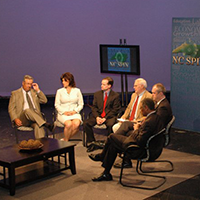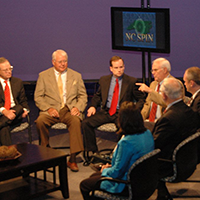Biotech's a smart bet
Published July 11, 2015
Editorial by Greensboro News-Record, July 11, 2015.
Spider-Man lives.
One of the more intriguing offspring of North Carolina’s biotech industry is a bulletproof vest woven from spider’s silk that is as tough and durable as Kevlar but lighter and more elastic.
The technology is being developed by a Charlotte company, Entogenetics, thanks, in part, to support from the N.C. Biotechnology Center, which provided a loan and helped the fledgling company connect to investors and customers.
The center may be needing one of those vests soon in the General Assembly, where its survival hangs in the balance. The proposed House budget has earmarked $13.6 million for the research and innovation nonprofit, headquartered in Research Triangle Park. The Senate: 0. It appears caught in an ideological web, stigmatized by its critics as a “giveaway.”
Far from it. The center actually is a catalyst for innovation that attracts bright minds and high salaries. With branches in Asheville, Charlotte, Winston-Salem, Greenville and Wilmington, the center helps to grow the biotech industry in the state from seed to harvest. It funds life science fellowships for undergraduate students. It provides grants to universities that support research that can be taken to the commercial marketplace. It offers loans for startups. It helps entrepreneurs find venture capital. And it recruits biotech companies to the state.
By almost any objective measure, the center is making a difference. A 2003 loan recipient, Entegrion, developed a bandage that helps stanch severe bleeding, and that has attracted $88 million in defense funding. A Duke University spin-off, Argos Therapeutics, developed a new cancer drug. Other companies are using duckweed, mushrooms and tobacco leaves to produce medicines.
The industry itself employs 61,000 North Carolinians at an average salary of $81,000 a year. Its annual economic impact is $73 billion. Life science jobs in the state grew at a rate of 30.9 percent from 2000 to 2012, or four times the national rate. In the Triad, biotech jobs have grown by 50 percent. The center’s research grants average a $28 return on each dollar invested.
As for that spider silk spun into bulletproof vests, it wasn’t easy: Spiders can’t be trained to produce silk. So scientists implanted spider genes into silkworms, which can.
Some may see as down side the gestation period for such research; it can take as long as 15 years for an idea to become a viable commercial product, if it pans out at all. But the payoffs appear to be well worth the wait and the risk.
Ideally, the center could sustain itself with private funding. But without an investment from the state, there probably won’t be a Biotech Center. And companies will go elsewhere, such as Texas, “which is really aggressive right now,” center President and CEO Doug Edgeton said in an interview this week.
Should the state continue to help tend this obviously fertile ground or let it go fallow? It doesn’t take a research scientist to know the answer.







